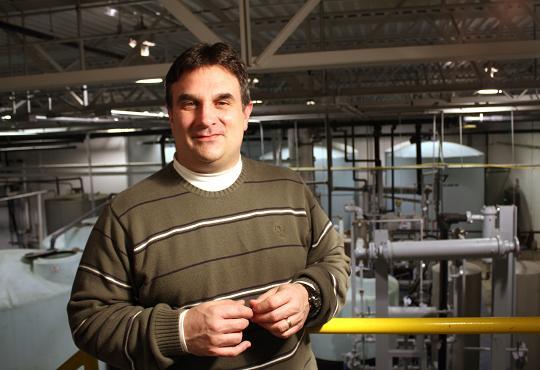OSU partners with startup to commercialize glycerin foam tech



Photo: Ohio State University
March 9, 2011
BY Luke Geiver
Ohio State University has teamed up with a biodiesel producer from Ohio on research based in glycerin technology that converts crude glycerin into polyurethane foam. The process was created by Yebo Li, a biosystems engineer for OSU’s Ohio Agricultural Research and Development Center located in Wooster, Ohio. Li has developed a process that converts crude glycerin created via biodiesel production into biopolyol, which is then used as the main component for the foam. The foam can be used in a wide range of products including automotive seats and bumpers, appliance applications such as thermal insulation systems from refrigerators, insulation boards, packaging materials, or the construction industry. “We have already tested our biopolyol products in automobile headrests,” Li told Biodiesel Magazine.
The patent-pending technology is going commercial with the help of Jeff Schultheis, COO of Poly-Green Technologies LLC, a startup based in Mansfield that was formed specifically to commercialize Li’s research. According to Schultheis, the biopolyol-based foam is “renewable, biodegradable and its quality is comparable to petroleum-based foam.” Because Poly-Green’s biopolyol-based foam uses a waste stream such as glycerin, Schultheis notes that the product is 5 to 10 percent cheaper that petroleum or natural oil-based foams. The current market for polyurethane is roughly $13 billion in the U.S., and creates a demand for 2.8 million tons of product.
Poly-Green hopes to start production and enter the market in the summer of this year, and the company recently purchased a 50-gallon reactor and has already put in an order for another 500-gallon reactor for use in the future. Schultheis believes the company could sell 1 million gallons a year for the next two years and over the next five years, he believes the company could grow from the three current employees to roughly 30. “So this will be a very good small business for the Mansfield area that desperately needs jobs,” he said.
Schultheis first started working with Li two years ago in an effort to curb glycerin waste produced at the Arlington Energy’s biodiesel facility. Since then, he said, Li and his students have worked hard to perfect the conversion process and make the technology more commercially viable. The process combines the crude glycerin with virtually any form of biomass, Li explained, under atmospheric pressure at an elevated temperature. During the process, methanol is recovered out of the crude glycerin with a distillation process. “Right now we are working on scale-up and also the consistency of the biopolyol because the glycerin coming in is always different,” he said, adding, “I would like to make more products, more polyurethane products and increase the applications of the biopolyol.”
Advertisement
Li’s work also received funding from the Ohio Soybean Council and from TechColumbus. “In the biodiesel industry,” Schultheis said, “we need to use all of our byproducts to be profitable and sustainable,” adding that if Poly-Green Technologies is successful, “we will make the biodiesel industry successful.”
Advertisement
Upcoming Events





